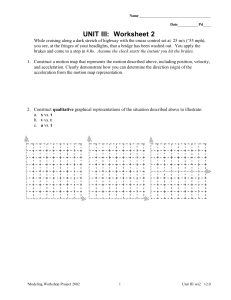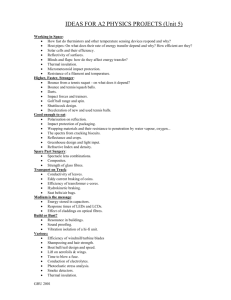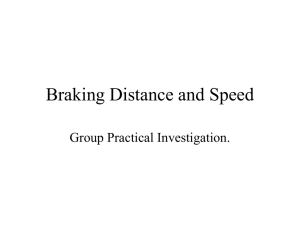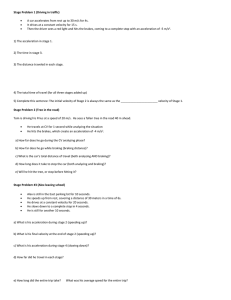ESTIMATED BRAKING EFFICIENCIES OF DIFFERENT and
advertisement
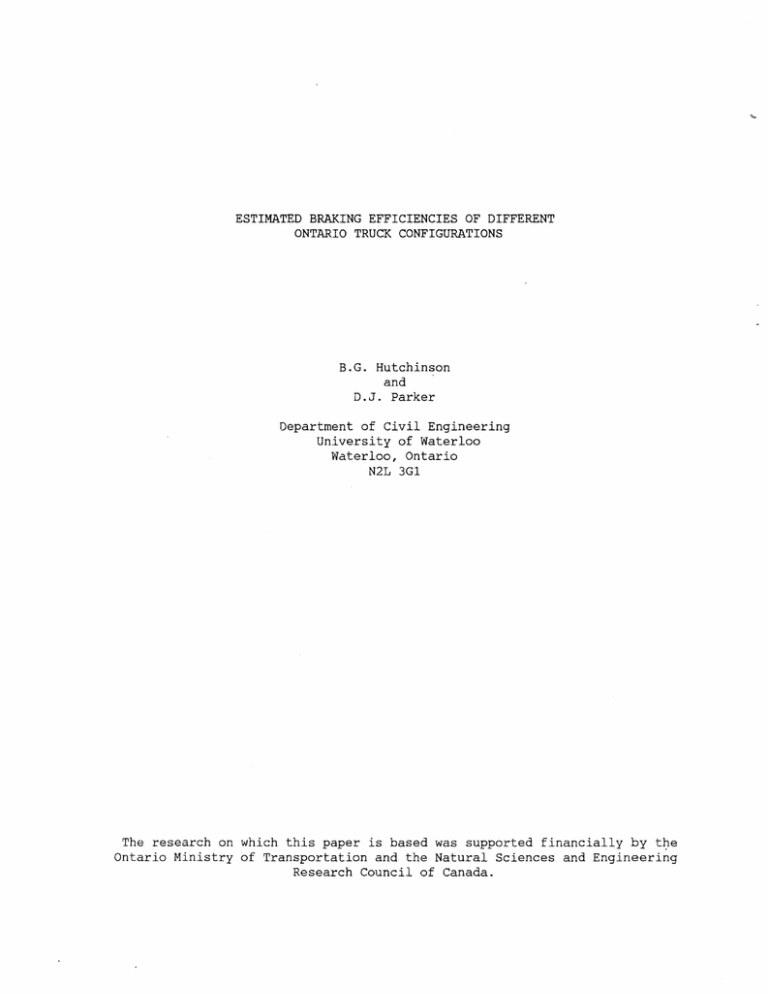
ESTIMATED BRAKING EFFICIENCIES OF DIFFERENT ONTARIO TRUCK CONFIGURATIONS B.G. Hutchinson and D.J. Parker Department of Civil Engineering University of Waterloo Waterloo, Ontario N2L 3Gl The research on which this paper is based was supported financially by t~e Ontario Ministry of Transportation and the Natural Sciences and Engineering Research Council of Canada. INTRODUCTION The braking capabilities of large trucks have been assessed in a number of studies conducted over the past five or six years. Many of these studies have concluded that the braking capabilties of very large trucks are inferior to the assumptions normally made by highway and traffic engineers in setting geometric and traffic operations standards. This paper describes the results of some computer analyses of the braking capabilities of a number of truck configurations commonly used in Ontario. These trucks include configurations that haul both "weigh-out" and "cube-out" cargoes. The paper also surrrrnarizes the results of some braking field tests reported in the literature and compares these test results with the behaviour estimated by the models. BRAKING EFFICIENCY The braking efficiencies of trucks are usually defined by [1] n = 100(a/f) where n = the braking efficiency (%); a = the deceleration achieved by the vehicle under controlled braking ·(ie. without lock-up at any wheel) in units of g; and f = the coefficient of tire-pavement friction. Perfect braking efficiency, or ideal braking, is achieved when the brake forces applied by the brakes at each wheel are proportional to the normal loads transmitted through each wheel. If this condition is not satisfied, then premature wheel lock-up will occur at one or more wheels and the available tire-pavement friction will not be fully mobilized. The brake force distribution on most heavy vehicles is usualy fixed at levels appropriate for the loaded condition and unloaded and partially loaded braking performance is usually inferior. The Canadian vehicle weights and dimensions study completed in 1987 set a 'reference level for braking efficiency of 70 percent, although no justification for this particular level has been provided. A surrrrnary of the results of this study provided by Sutherland and Pearson (1989) showed that a conventional tractor semi-trailer, the A-, B- and C-train doubles could all achieve this standard. It is not clear if these braking performances were for loaded, partially loaded and unloaded vehicles. Impacts of Deviations from Ideal Braking The implications of variations from ideal braking are illustrated in Figure 1 which shows the braking distances from 40 mi/hr (64.4 km/h) observed in braking tests on dry pavements for a range of vehicle types (buses, straight trucks and semi-trailers) for deviations from ideal braking on the front axle for both loaded and unloaded vehicles. The diagram shows that the braking distances for both loaded and empty vehicles approach a minimum braking distance of 45.7 m as the percent braking on the front axle approaches the ideal. Or, conversely, when the braking . deviates widely from the ideal, the braking distance more than doubles. The braking distance formula used in the geometric design standards would suggest a braking distance of about 30 m from this test speed, lower than that observed in the braking field tests on dry pavements. 150--------------------------~ x -loaded o-unloaded braking from 64.4 km/h o 000 XO 000 ox x x x Xx x Ox 0 o xx xX x o I I I I 0.2 0.4 0.6 0.8 x I - x I O~-----~-----~-----~~~~~~~~ 1.0 1.2 ACTUAL % BRAKING ON FRONT AXLE IDEAL % BRAKING ON FRONT AXLE Figure 1. Braking Distance vs Front Axle Deviation from Ideal Braking BRAKING MODELS Hutchinson and Parker (1989) have described the braking models used to calculate the braking capabilities reported in this paper. The models are adaptations of those developed by the University of Michigan Transportation Research Institute and reported by Mathew (1987). These models calculate the forces acting on a braking vehicle at various levels of brake pedal pressure and the brake pedal pressure that produces incipient wheel-lock up at one or more axles is used to identify the maximum deceleration under controlled braking, and therefore, braking efficiency. Figure 2 shows the free-body diagrams equations of a tractor and a belly-axled semi-trailer. The vehicles were equipped with brakes having the properties reported by Radlinski and Williams (1985) for a number of the vehicle types. The brake forces delivered were modified according to the operating speed as follows: initial speed (km/h) multiplier 40 1.1 &0 1.0 80 0.9 100 0.8 TRUCK TYPES ANALYSED Figure 3 illustrates the four basic truck types analyzed. The three axle truck is representative of the dump trucks that operate in and around urban areas. In the analyses described. in this paper it has been loaded with a cargo of density 17 000 N/m 3 (gravel) up to the maximum tandem axle load permitted by Ontario regulations. XRA h2A hA FXA FZ1 = = F84 + Fss + FBBt - M2 a + FXB W1 + FZA - FZRl Figure 2. Free-Body Diagrams for Tractor and Semi-Trailer 3-AXLE STRAIGHT TRUCK tare = 8 619 kg GVM = 24 816 kg I+-- 3.0Sm --tI I ~--@)\Q}~0~ -d J+-- 3.S6m ~ TRACTOR SEMI-TRAILER tare tractor semi-trailer 8 200 kg 6 300 kg GVM = 24 532 kg 1+11-----14.63m ------tl~1 ~~------~-0~.1 14- 4.82m -I~~14---- 10.S9m ----+l~1 TRACTOR SEMI-TRAILER WITH BELLY AXLES tare tractor 8 200 kg GVM = 56 820 kg semi-trailer 6 300 kg 14 14.63m _I ~II~II@!~ 14- 4.82m -+14- 4.S9m ~ 3.00m-.t+-4.1Sm-.t B-TRAIN DOUBLE tare tractor 1st semi2nd semi- 8 200 kg 6 000 kg 4 300 kg GVM = 50402 kg 12.17m Figure 3. Truck Configurations Analyzed The conventional 3S-2 has been loaded with a "cube-out" cargo of density 1000 N/m 3 which is representative of the consumer goods transported by many 3S-2's. The belly-axled semi-trailer illustrated in Figure 3 is an example drawn from the gravel carriers that haul into the Toronto construction market from the adjacent glacial gravel deposits. It has been loaded with gravel which produces a GVM of 56 820 kg. The fourth vehicle illustrated in Figure 3 is a B-train double that is frequently used to carry dense cargoes such as rolls of steel, steel plate, beer, etc. It has also been loaded with a cargo of density of 17 000 N/m 3 • The diagram illustrates that each of the three combination 'vehicles has been equipped with the same tractor unit. ESTIMATED BRAKING EFFICIENCIES Figure 4 shows the braking efficiencies estimated for the four truck types illustrated in Figure 3, and the tractor operating alone. For the braking efficiencies shown, braking was from 100 km/h on dry pavements with a coefficient of tire-pavement friction of 0.5. Braking efficiencies for the unloaded and parially loaded conditions are also displayed. Braking from 100 km/h STRAIGHT 3-AXLE I 3-S2 half unloaded from rear I 'E I BOBTAI1 ~ "0 E tI.l 3-S5/2B (XXl<X~< ..: .. ••• "0 .:-:-0:%. ./.1 . Q) tI.l I 0 0.. 0 .... 0.. ~llif$.-::}~£0XXXX:>:.X(X; 3-S2-S2 .... both trailers unloaded rear unloaded I I I 10 20 m loaqed I . xSi:;"<g. ~·:;(!~x-:o.=$:xx:< I I I I I 30 40 80 50 60 70 BRAKING EFFICIENCY (%) I 90 100 Dunloaded Figure 4. Braking Efficiencies of Differ~nt Truck Types The diagram indicates that each of the loaded vehicles was just able to achieve the 70 percent braking standard, except for the 3-SS/2B. The inferior performance of the loaded 3-SS/2B is due to the use of the Radlinski and Williams's brakes which produced an under-braked vehicle for this heavily loaded gravel carrier. The most important feature illustrated by Figure 4 is the degradation in braking efficiency of the unloaded vehicles. The bob-tail tractor, the 3SS/2B and the B-train double have unloaded braking efficiencies of about 40 percent, while the B-train double has a braking efficiency of only 25 percent with the rear-trailer unloaded. The braking efficiencies and the degradation in braking efficiencies at other speeds and different tire-pavement friction magnitudes are similar to those. shown in Figure 4. Higher coefficients of friction and higher speeds resulted in lower braking efficiencies of the loaded vehicles because of the greater forward shift in loads. However, these changes in braking efficiency were only marginal. BRAKING DISTANCES The validity of the above estimates of braking efficiency may be assessed by comparing the braking distances calculated by the simplified braking models with field observations. Radlinski and Williams (1985) have reported braking distance results for a range of vehicle types and these are summarized in Figure 5. Braking was from 100 km/h on dry pavements with tires and brakes in excellent condition. The diagram also shows a braking distance of 130 m which is used in geometric design standards for an operating speed of 100 km/h. It should be recalled that this distance is calculated from an assumed tire-pavement coefficient of friction of 0.30, which is representative of partially worn tires operating on wet pavements. LOADED STRAIGHT TRUCKS LOADED TRACTOR SEMI-TRAll..ERS EMPTY TRUCKS & SEMI-TRAll..ERS BOBTAIL TRACTORS o 200 100 50 BRAKING DISTANCE (m) Braking Models Radlinski & Williams h:::::::::::1 f = 0.6 'M:~i mnurnwn c:::J range Figure 5. Comparison of Model-Estimated and Observed Braking Distances Figure 5 illustrates that the loaded straight trucks and semi-trailers have braking distances of less than the standard, but that the dry pavement braking of empty vehicles and bob-tail tractors approach, or exceed this standard (which is based on wet pavements). Figure 5 also summarizes the braking distances estimated by the braking models for dry pavement braking from 100 km/h. A comparison of the modelestimated and observed braking distances in Figure 5 shows that the models are capable of capturing the observed behaviour. This general agreement between the model-estimated and observed magnitudes helps to provide some credibility to the braking efficiencies summarized in the previous section. Fancher (1986) has presented evidence to show that trucks with worn tires (but still legal) require braking distances substantially longer than those recommended by the AASHTO standards. Figure 6 illustrates the braking distances reported by Fancher for trucks braking on wet roads with new tires and for worn tires. The diagram illustrates that controlled stops by trucks from 90 km/h require braking distances that are approximately equal to those specified by the standards for 130 km/h. 600r-----------------------------------~ braking tests on wet pavements for 3S-2's new tires 30 50 70 90 110 130 SPEED (kmIh) Figure 6. Comparison of Model-Estimated and Observed Braking Distances at Different Speeds The braking models have also been used to estimate the braking distances for the conditions reported by Fancher using a 3S-2 loaded with low density cargo (1 000 N/m 3 ) with a coefficient of tire-pavement friction of 0.2. The model-calculated distances have been superimposed on Figure 6. A comparison of the observed and estimated braking distances shows that the model overestimates braking distances for speeds of less than 90 km/h and underestimates the braking distances at higher speeds. The braking models might better capture the observed braking distances if appropriate brake force multipliers were available to reflect braking degradation at speeds greater than 100 km/h and if a variable coefficient of tire-pavement friction were used. The comparison provided in Figure 6 also supports the use of the simplified models for analyzing the relative braking efficiencies of the different truck types. TRUCK ACCIDENT EXPERIENCE Buyco, Saccomanno and Stewart (1987) have conducted a comprehensive analysis of truck accidents on the Provincial highway system in Ontario using data for 1983. The 1983 accident file was used because the accident data could be supplemented with truck exposure information derived from a province-wide survey of commercial vehicles. Table 1 summarizes the accident rates by truck type calculated in that study. The accident rate entries show that the unloaded vehicles had higher accident rates than loaded vehicles, except for the twin trailers. The twin trailer data need to be interpreted with caution because of the small number of units using the Ontario highway system in 1983. Table 1. Highway Accidents by Truck Type in Ontario, 1983 Truck Type Empty Straight Truck Bobtail Tractor Empty Tractor Semi-Trailer Loaded Straight Truck Loaded Tractor Twin Trailer Loaded Tractor Semi-Trailer Unloaded Tractor Twin Trailer Accident Rate (number/M km) 2.62 1.74 1.32 1.27 0.75 0.58 0.51 The information presented in Figure 4 showed that 3-axle straight trucks had the smallest degradation in braking efficiency when unloaded. The increased accident rate for unloaded straight trucks presented in Table 1 is not completely consistent with the model-estimated changes in braking efficiency. However, many of the straight trucks using the Provincial highway system tend to operate in the higher traffic volumes found around urban areas. The accident rates reported in Table 1 are for all traffic volume conditions. CONCLUDING REMARKS Braking distance-related geometric design and traffic operations standards are based on an assumption of perfect braking efficiency and a coefficient of tire-pavement friction that represents worn tires operating on wet pavements. These two sets of assumptions imply that highway vehicles are able to achieve a braking deceleration of 0.3 g. The model-based analyses of the braking efficiencies of a number of Ontario truck types showed that most of these trucks approached the 70 percent reference standard when they. were fully loaded. The braking efficiencies decreased substantially when the trucks were partially unloaded or unloaded. The braking efficiency of the unloaded 3S-2 decreased to about 50 percent when half-unloaded from the rear. Bob-tail tractors, ~nloaded belly-axled semi-trailers, partially and fully unloaded twin trailers had braking efficiencies of 30-40 percent. This degradation in braking efficiency indicates that many partially loaded and unloaded large trucks are unable to meet the deceleration magnitudes assumed in highway standards, except under very good pavement conditions. A comparison of model-estimated braking distances with braking field test data indicate that the models are capable of capturing the relative braking efficiencies of different truck types. The results summarized in this paper suggest that existing braking distance standards should be carefully evaluated in the light of this evidence on truck braking efficiencies. The results also suggest that public policies need to be adopted to regulate the movement of large trucks when weather conditions produce poor pavement conditions. REFERENCES Fancher, P.S. (1986) "Sight Distance Problems Transportation Research Record 1052, pp. 77-89. Related to Large Trucks", Hutchinson, B.G. and Parker, D.J. (1989) "Parametric Analyses of Large Trcuk Braking Efficiencies", Canadian Journal of Civil Engineering, 15, April. Mathew, A. (1986) "Simple Models: User's Manual", The University of Michigan Transportation Research Institute, February. Radlinski, R.W. and Williams, S.F. (1985) "NHTSA Heavy Vehicle Brake Research Program: Report No. 1 - Stopping Capability of Air Braked Vehicles", DOT HS 806 738, National Highway Traffic Safety Administration, U.S. Department of Transportation, Washington, DC. Sutherland, J.R. and Pearson, J.R. (1989) "Key Findings of the Canadian Vehicle Weights and Dimensions Study", Proceedings, 11th World Meeting, International Road Federation, V, pp. 84-87.

